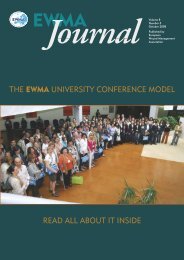best practice for the management of lymphoedema ... - EWMA
best practice for the management of lymphoedema ... - EWMA
best practice for the management of lymphoedema ... - EWMA
You also want an ePaper? Increase the reach of your titles
YUMPU automatically turns print PDFs into web optimized ePapers that Google loves.
Exercise/movement and elevation<br />
Exercise/movement are common<br />
rehabilitative interventions used to reduce<br />
oedema. At present, <strong>the</strong>re is little evidence to<br />
indicate which types, intensities and<br />
frequencies <strong>of</strong> exercise may be safely used in<br />
<strong>the</strong> <strong>management</strong> <strong>of</strong> <strong>lymphoedema</strong>.<br />
EFFECTS OF EXERCISE/MOVEMENT<br />
Exercise improves muscular strength,<br />
cardiovascular function, psychological<br />
wellbeing and functional capacity. Gentle<br />
resistance exercise stimulates muscle pumps<br />
and increases lymph flow; aerobic exercise<br />
increases intra-abdominal pressure, which<br />
facilitates pumping <strong>of</strong> <strong>the</strong> thoracic duct 76 .<br />
TAILORED EXERCISE/MOVEMENT<br />
PROGRAMMES<br />
Combinations <strong>of</strong> flexibility, resistance and<br />
aerobic exercise may be beneficial in<br />
controlling <strong>lymphoedema</strong> 77-79 , and<br />
should be tailored to <strong>the</strong> individual patient<br />
(Box 36). Physio<strong>the</strong>rapy referral is required<br />
<strong>for</strong> patients who have difficulty with mobility,<br />
joint function or joint movement.<br />
ELEVATION<br />
Elevation <strong>of</strong> <strong>the</strong> affected limb, ideally to just<br />
above <strong>the</strong> level <strong>of</strong> <strong>the</strong> heart, is <strong>of</strong>ten advised<br />
to reduce swelling. It is thought that elevation<br />
acts by maximising venous drainage and by<br />
decreasing capillary pressure and lymph<br />
production.<br />
BOX 36 General guidelines on exercise<br />
Anecdotal evidence suggests that limb<br />
elevation when <strong>the</strong> patient is sitting or in bed<br />
may be a useful adjunct to active treatment,<br />
but should not be allowed to impede function<br />
or activity. Patients should be encouraged not<br />
to sleep in a chair and to go to bed at night to<br />
avoid <strong>the</strong> development <strong>of</strong> 'arm chair' legs or<br />
exacerbation <strong>of</strong> lower limb <strong>lymphoedema</strong>.<br />
EXERCISE<br />
■ Patients should be encouraged to maintain normal functioning, mobility and<br />
activity<br />
■ Exercise/movement should be tailored to <strong>the</strong> patient's needs, ability and<br />
disease status<br />
■ Patients should be encouraged to include appropriate warming up and<br />
cooling down phases as part <strong>of</strong> exercise to avoid exacerbation <strong>of</strong> swelling<br />
■ Compression should be worn during exercise<br />
■ Expert patients can help to demonstrate, teach and monitor exercise, and<br />
provide in<strong>for</strong>mation on access to local exercise programmes<br />
Types <strong>of</strong> exercise:<br />
■ start with low to moderate intensity exercise<br />
■ paralysed limbs can be moved passively<br />
■ walking, swimming, cycling and low impact aerobics are recommended<br />
■ heavy lifting and repetitive motion should be avoided<br />
■ flexibility exercises maintain range <strong>of</strong> movement<br />
BEST PRACTICE FOR THE MANAGEMENT OF LYMPHOEDEMA 47

















